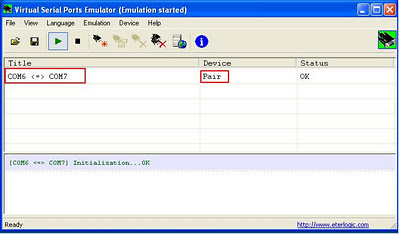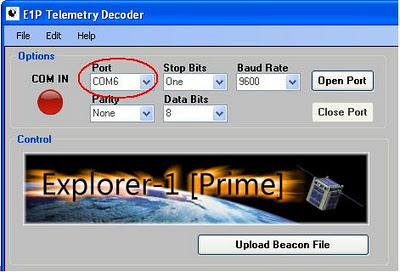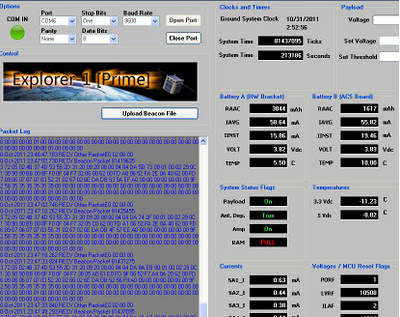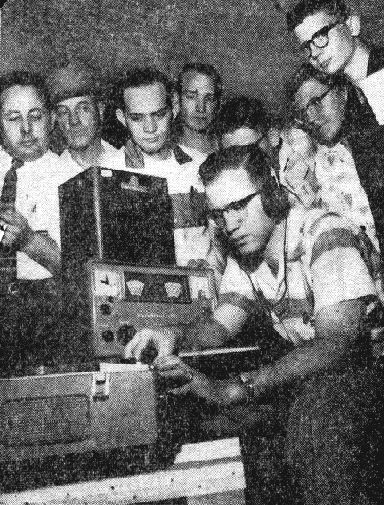eg PORT6=port7.

2- Setup MixW Mode as following

3- Setup MixW TNC Emulation as following

4-Downloading and Installing E-1P Telemetry Decoder:
1) Download the E-1P Telemetry Decoder program here: E-1P Telemetry Decoder2) Double click E1P Telemetry Decoder.msi to start the Windows install wizard.
a. Click Next to start the wizard
b. The default install folder is: C:\Program Files\MSU\E1p Telemetry Decoder\ Click Next to confirm installation folder
c. Click Next to start installation*
d. Click Close to finish
3) The E1P Telemetry Decoder program is now installed here: C:\Program Files\MSU\E1p Telemetry Decoder\E1P Telemetry Decoder.exe
4) A desktop shortcut is automatically created.
Sourse
5- Setup the E-1P Telemetry Decoder as following.

7- Raw Data Rx by MixW looks like this.

8-E-1P Telemetry Decoder well analyzed the received data to different values.

9- Decoded Packet received on
30-Oct-2011 23:45:29.527 RECV Other PacketE0 02 00 00
30-Oct-2011 23:45:45.043 RECV Beacon Packet 81390535
33 72 05 02 4B 37 4D 53 55 2D 31 20 09 20 08 00 84 04 D9 EB C7 00 01 00 02 29 0C 31 30 90 90 BB 00 0F F0 0F 04 F6 78 06 E0 62 00 FD A1 06 55 F7 C6 0A 80 62 20 FD 14 0A 06 06 07 07 03 52 20 02 67 02 6E DB DC 4F 58 00 A0 00 00 00 00 00 00 00 9F 02 58 35 35 35 35 35 35 00 00 00 00 00 00 00 00 00 00 00 00 00 00 00 00 00 00 00 00 00 00 00 00 00 01 00 00 00 00 00 00 00 00 00 00 00 00 00 00 00 00 00 00 00 00 00 00 00 00 00 00 00 00 00 01 00 00 00 00
30-Oct-2011 23:45:45.058 RECV Other PacketE0 02 00 00
30-Oct-2011 23:46:00.590 RECV Beacon Packet 81396355
33 72 05 02 4B 37 4D 53 55 2D 31 20 09 20 08 00 84 04 DA 02 83 00 01 00 02 29 0C 31 30 90 90 BB 00 0F F0 0F 04 F7 EE 06 C0 62 00 FD A0 06 54 F7 C6 0A 80 62 20 FD 17 09 07 06 07 07 03 53 21 02 66 02 6E DB DC 4F 58 EF A0 00 00 00 00 00 00 00 9F 02 58 35 35 35 35 35 35 00 00 00 00 00 00 00 00 00 00 00 00 00 00 00 00 00 00 00 00 00 00 00 00 00 00 00 01 00 00 00 00 00 00 00 00 00 00 00 00 00 00 00 00 00 00 00 00 00 00 00 00 00 00 00 00 00 01 00 00
30-Oct-2011 23:46:00.590 RECV Other PacketE0 02 00 00
30-Oct-2011 23:46:16.121 RECV Beacon Packet 81402175
33 72 05 02 4B 37 4D 53 55 2D 31 20 09 20 08 00 84 04 DA 19 3F 00 01 00 02 29 0C 31 30 90 90 BB 00 0F F0 0F 04 F7 EE 06 80 62 00 FD A0 06 54 F7 C4 0A 80 62 20 FD 17 0A 07 06 06 07 03 56 1F 02 67 02 6E DB DB 50 59 F2 A0 00 00 00 00 00 00 00 9F 02 58 35 35 35 35 35 35 00 00 00 00 00 00 00 00 00 00 00 00 00 00 00 00 00 00 00 00 00 00 00 00 00 00 00 01 00 00 00 00 00 00 00 00 00 00 00 00 00 00 00 00 00 00 00 00 00 00 00 00 00 00 00 00 00 01 00 00
30-Oct-2011 23:46:16.137 RECV Other PacketE0 02 00 00
30-Oct-2011 23:46:31.652 RECV Beacon Packet 81407995
33 72 05 02 4B 37 4D 53 55 2D 31 20 09 20 08 00 84 04 DA 2F FB 00 01 00 02 29 0C 31 30 90 90 BB 00 0F F0 0F 04 F7 42 06 40 62 00 FD A0 06 53 F7 C4 0A 60 62 20 FD 17 0A 06 06 07 07 03 53 1E 02 67 02 6E DA DC 53 58 EC A0 00 00 00 00 00 00 00 9F 02 58 35 35 35 35 35 35 00 00 00 00 00 00 00 00 00 00 00 00 00 00 00 00 00 00 00 00 00 00 00 00 00 01 00 00 00 00 00 00 00 00 00 00 00 00 00 00 00 00 00 00 00 00 00 00 00 00 00 00 00 00 00 00 00 01 00 00
30-Oct-2011 23:46:31.683 RECV Other PacketE0 02 00 00
30-Oct-2011 23:46:47.168 RECV Beacon Packet 81413815
33 72 05 02 4B 37 4D 53 55 2D 31 20 09 20 08 00 84 04 DA 46 B7 00 01 00 02 29 0C 31 30 90 90 BB 00 0F F0 0F 04 F7 42 06 20 62 00 FD 9F 06 53 F7 DF 0A 40 62 20 FD 17 0A 07 06 07 07 04 53 20 02 67 02 6E DA DC 52 55 F3 A0 00 00 00 00 00 00 00 9F 02 58 35 35 35 35 35 35 00 00 00 00 00 00 00 00 00 00 00 00 00 00 00 00 00 00 00 00 00 00 00 00 00 01 00 00 00 00 00 00 00 00 00 00 00 00 00 00 00 00 00 00 00 00 00 00 00 00 00 00 00 00 00 01 00 00 00 00
30-Oct-2011 23:46:47.183 RECV Other PacketE0 02 00 00
30-Oct-2011 23:47:02.730 RECV Beacon Packet 81419635
33 72 05 02 4B 37 4D 53 55 2D 31 20 09 20 08 00 84 04 DA 5D 73 00 01 00 02 29 0C 31 30 90 90 BB 00 0F F0 0F 04 F7 32 06 00 62 00 FD A0 06 52 FA 2E 0A 40 62 00 FD 17 09 06 07 07 07 03 52 21 02 67 02 6E DA DB 53 5A EF A0 00 00 00 00 00 00 00 9F 02 58 35 35 35 35 35 35 00 00 00 00 00 00 00 00 00 00 00 00 00 00 00 00 00 00 00 00 00 00 00 00 00 00 00 01 00 00 00 00 00 00 00 00 00 00 00 00 00 00 00 00 00 00 00 00 00 00 00 00 00 00 00 00 00 01 00 00
30-Oct-2011 23:47:02.746 RECV Other PacketE0 02 00 00
30-Oct-2011 23:47:18.262 RECV Beacon Packet 81425455
33 72 05 02 4B 37 4D 53 55 2D 31 20 09 20 08 00 84 04 DA 74 2F 00 01 00 02 29 0C 31 30 90 90 BB 00 0F F0 0F 04 F7 32 05 C0 62 00 FD A1 06 52 FA 2E 0A 40 62 00 FD 16 09 07 06 07 07 03 56 21 02 67 02 6E DA DB 4F 57 EE A0 00 00 00 00 00 00 00 9F 02 58 35 35 35 35 35 35 00 00 00 00 00 00 00 00 00 00 00 00 00 00 00 00 00 00 00 00 00 00 00 00 00 00 00 01 00 00 00 00 00 00 00 00 00 00 00 00 00 00 00 00 00 00 00 00 00 00 00 00 00 00 00 00 00 01 00 00
30-Oct-2011 23:47:18.262 RECV Other PacketE0 02 00 00
30-Oct-2011 23:47:33.824 RECV Beacon Packet 81431275
33 72 05 02 4B 37 4D 53 55 2D 31 20 09 20 08 00 84 04 DA 8A EB 00 01 00 02 29 0C 31 30 90 90 BB 00 0F F0 0F 04 F7 38 05 A0 61 E0 FD 9F 06 52 F7 A4 0A 20 62 00 FD 16 09 06 06 07 07 03 52 20 02 66 02 6E DA DB 52 56 F9 A0 00 00 00 00 00 00 00 9F 02 58 35 35 35 35 35 35 00 00 00 00 00 00 00 00 00 00 00 00 00 00 00 00 00 00 00 00 00 00 00 00 00 01 00 00 00 00 00 00 00 00 00 00 00 00 00 00 00 00 00 00 00 00 00 00 00 00 00 00 00 00 00 00 00 01 00 00
30-Oct-2011 23:47:33.840 RECV Other PacketE0 02 00 00
30-Oct-2011 23:47:49.293 RECV Beacon Packet 81437095
Notice use USB for receiving E1P-2U at 437.505.
Good luck





































